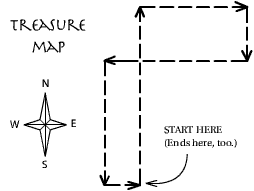MAGNETISM LESSON 6
The
Treasure Map
Lesson Notes:
- We are ignoring the correction for the difference
between magnetic north and geographic north. This will not interfere in
any way with the lesson. It also doesn't matter how large the child's paces
are, as long as the size of pace is consistent.
- Most children are likely to need a little help learning how to use
their compass to determine direction. Example: suppose you want to walk
eight paces west. Turn the compass so the red end of the needle points
to the N. The W will point left. Just turn left and walk eight paces.
- If your children decide to make their own treasure map, as it suggests
at the end of the lesson, they'll have the best success if they keep it
outdoors, away from metal, and keep it simple, remembering that tiny errors
are magnified with each new direction.
Objectives: Through completing this lesson the child will: 1) Apply knowledge of
the Earth's magnetic field to a problem solving situation; 2) Use a compass
to determine direction, and to navigate. |
Key:

Since people are not machines and their paces are not all exactly the
same size, the child may be off a little.
- How far from skull rock was the treasure buried? [Zero paces]
- Did you find any treasure? [If knowledge is treasure, then I
have been made rich.]
Further Explorations (optional):
A pacing map is a vector map. (A vector is something that has
a size, such as 3 paces, and a direction, such as east.)
Vectors can always be added in any order. You can try it with the pacing
instructions in the lesson, or come up with your own instructions. If you
want to verify this but don't want to pace it off, just use a sheet of
graph paper, with each square representing a pace. |